How to Buy the Best Sleeping Bag
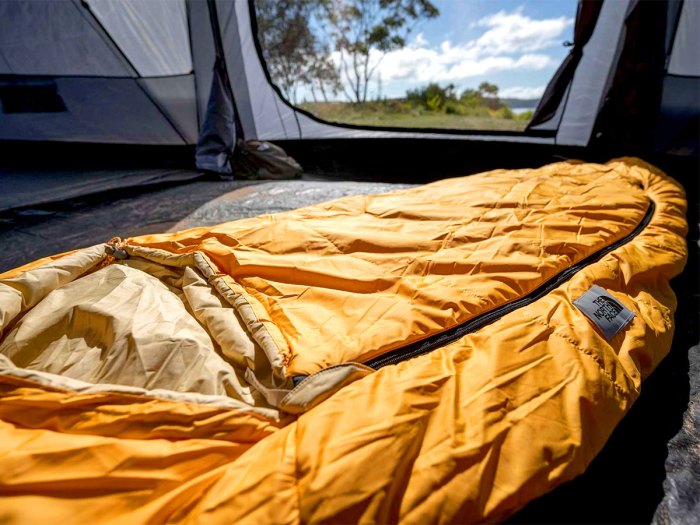
- Find expert tips to help you get a good night’s sleep
- Picking the right sleeping pad, bag liner, pillow or cot
- How to minimize smelly sleeping bag odor
A good sleeping bag can make the difference between comfort and a long, miserable night. Follow these tips on choosing the right sleeping bag for your adventures.
KNOW YOUR BODY
If you are always wearing a T-shirt in camp when others are wearing a fleece — and you’re not cold — get a bag rated about 10 degrees lower than the lowest temperatures you encounter on trips. If you’re one
of the first people to put on an insulated jacket while hanging around camp, get a bag rated 20-25 degrees lower than the coldest nights you anticipate.
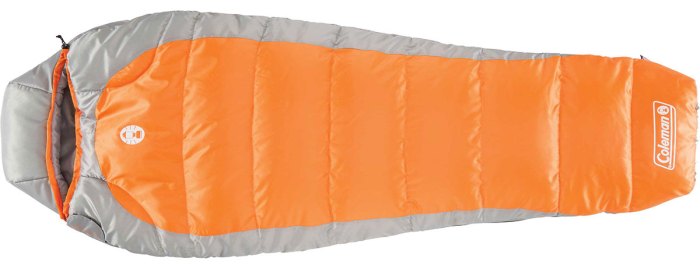
YOU CAN HARDLY BEAT THE PRICE of the COLEMAN SILVERTON 25 DEGREE MUMMY SLEEPING BAG ($69, coleman.com), but that’s just one great factor. Stuffed with synthetic insulation with offset quilt construction that eliminates cold spots — along with a draft tube, an adjustable hood and even a pillow pocket — this bag will keep many campers warm in temps around freezing and above. Sized for sleepers up to 6 feet, 2 inches, it has a spacious foot box and two-way zipper in case you need to ventilate from the top and bottom on mild nights. One downside: It’s heavy and bulky, better for car camping.
KNOW YOUR BUDGET
Prices vary depending on factors like type and quality of insulation, as well as materials used. For instance, a bag rated to zero degrees uses much more insulation than a 30-degree bag.
TEMPERATURE RATINGS
Sleeping bags usually are rated for the lowest temperature used. Many manufacturers use the EN or ISO rating system, a standardized measurement of warmth.
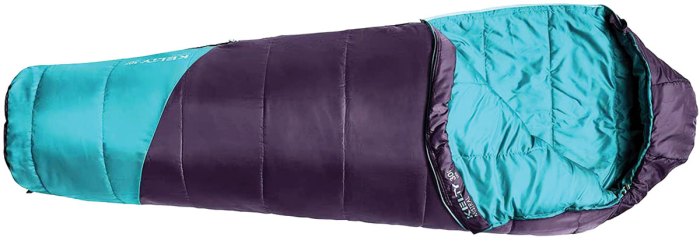
GEARING UP FOR YOUR FIRST CAMPING OR BACKPACKING TRIPS? The affordable and functional KELTY KIDS MISTRAL 30 ($50, kelty.com) is a great choice. The Cloudloft synthetic insulation will retain heat even if it gets damp, and the adjustable hood opening helps seal in heat. Plus, its weight and packability make it one of the most affordable bags that can cross over from car camping to backpacking.
SYNTHETIC VS. DOWN INSULATION
There are two main types of insulation: down and synthetic.
Down is generally warmer, lighter and more packable than synthetic insulation — especially higher-quality down (rated 800-fill and above). But it’s typically more expensive and loses its ability to keep you warm if it becomes wet. There is some water-resistant down.
Synthetic retains its ability to trap heat if the bag gets wet. These sleeping bags are usually heavier and less packable than down bags, but they are also less expensive. They’re the best choice for wet adventures.
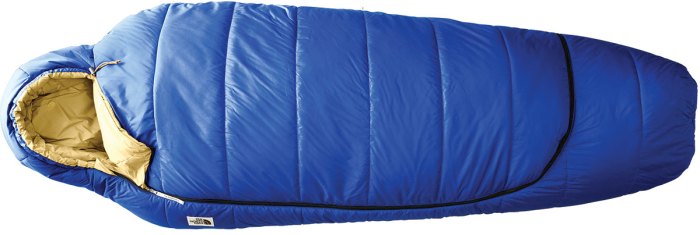
THE DRAWBACK OF LOW-PRICED SYNTHETIC BAGS IS THEY CAN BE TOO HEAVY ND BULKY FOR BACKPACKING. Enter THE NORTH FACE ECO TRAIL SYNTHETIC 20 SLEEPING BAG ($129, thenorthface.com). At under 4 pounds (regular length) and packing down to 10-by-18 inches, this mummy bag is made for backpackers on a budget. Its EN limit rating of 20 degrees derives from recycled synthetic insulation — in fact, all materials that go into the bag are recycled, except for the zipper teeth. A wraparound J-zipper and extra width in the knees make it feel roomier than many mummy bags and expands options for ventilating. And it comes in unisex sizes ideal for Scouts nearing adulthood.
WEIGHT
This matters when you’re backpacking, but less so when car camping.
Lighter, higher-quality insulation costs more, but you can also reduce weight and bulk by not buying a 15-degree bag when you need only a 30-degree bag.
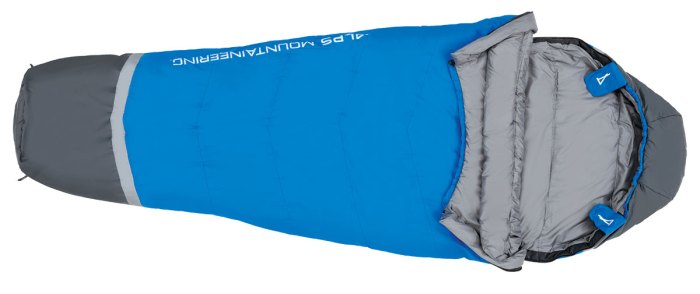
DON’T NEED EXTRA WARMTH OR THE WEIGHT AND COST THAT COME WITH IT? The ALPS MOUNTAINEERING AURA +35° ($100. alpsmountaineering.com), made for mild summer nights, weighs in under 3 pounds and packs down to 8 ½-by-16 ½ inches. The synthetic insulation is packaged within two-layer offset construction that eliminates cold spots and is buttressed by a zipper draft tube. Bonus: It comes with a compression stuff sack.
MUMMY VS. RECTANGULAR SHAPE
Mummy bags taper from head to foot for thermal efficiency (less space to heat up) and to minimize weight and bulk, but some can feel claustrophobic.
Rectangular bags are more spacious, but are generally heavier, bulkier and sometimes have cold spots.
Treat a bag like boots: Try it on before buying.
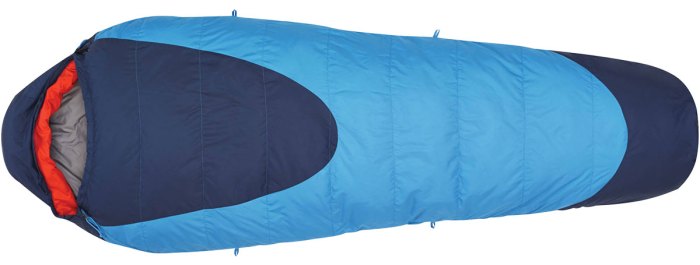
THE KELTY COSMIC DRIDOWN 20 ($160, kelty.com) isn’t the least expensive bag on this list, but it might be the best value. Built for three-season backpacking with an EN limit rating of 19 degrees, the Cosmic is generously stuffed with water-resistant 600-fill down, packs down to 8-by-15 ½ inches and weighs under 2 ½ pounds. The dual-slider zipper doesn’t snag, and the hood and draft collar keep warmth inside. It comes in three lengths, including a small for people up to 5 feet, 6 inches. Try finding a bag with all those features at this price.
CONSTRUCTION
Less expensive, yet lightweight, bags have sewn-through baffles, which can create cold spots along seams. Higher-quality horizontal baffles are typically warmer. Also look for a draft tube (along the zipper), collar (inside the hood) and no-snag zipper guard.
GEAR GUY’S ADVICE?
Get what you can afford. With an inexpensive bag, you can still get outdoors, which is what’s most important, right? If and when you have the dough for a nicer bag, it will make your wilderness adventures a little more luxurious.
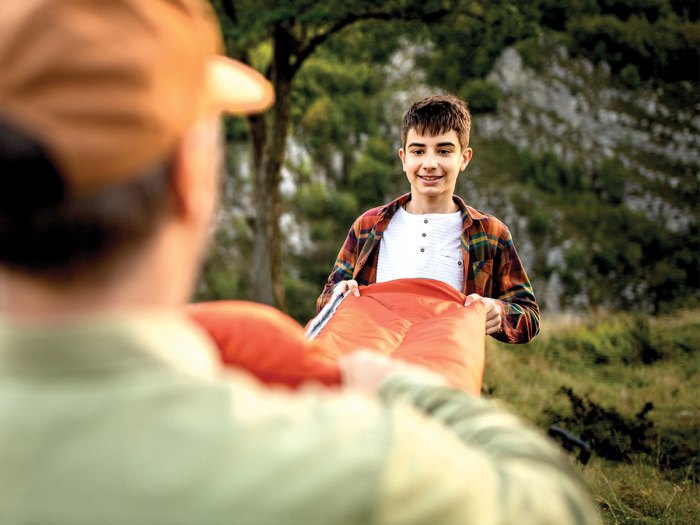
CARING FOR YOUR BAG
Properly cared for, a sleeping bag can last 10-20 years. Body oils can compromise insulation, so to prolong your bag’s life, you should sleep in clean base layers. Air out your bag after each night of camping, but don’t leave it exposed to sunlight for long periods.
Post-trip, hang the bag to dry for a day or two, and then place it in a big storage sack or an old pillowcase. Be sure to store it in a dry place. If your bag gets really dirty or starts losing loft, follow the manufacturer instructions for washing it.
I recommend and use the GuideGear -15 or 0 degree green sleeping bags for colder weather and the Coleman 40 degree bags (I have a big and tall one as a scoutmaster) and they are both budget friendly and excellent bags.
I would choose rectangular because I am always so hot 🔥🥵.
A good bag that I got is the Klymit KSB 20° sleeping bag. It’s comfy, and it keeps me warm outside. It also keeps me dry. I got it for only 70$ on sale at Costco Online.
What is the best 0 degree sleeping bag?
I agree the military excess is great for scouts. Very versatile.
I need a light weight sleeping bag that I can use for backpacking for under $100. What would you reccomend?
The GI ECW sleep system is very versatile and rugged. It consists of a gore-Tex bicycle with a lightweight and medium weight bags. They can be combined to deal with many different climates comfy.
I recommend buy6a 40* bag, a fleece bag and a ” silk” liner bag. That way you have options in warmer weather and can layer the8to get the temperature rating really low.
The EMS Solstice is a good 20 Degree bag at a decent price. I recommend it to my Scouts. It’s about $99 regularly, but on sale as low as $60 occasionally. No Affiliation
those are really cool and nice sleeping bags to sleep in the same for the tents
Need a new sleeping bag
I’m almost a boy scout and I’m looking for a good sleeping bag any ideas?